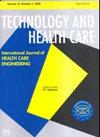Application value of real-time shear wave elastography in the diagnosis and efficacy evaluation of venous thrombosis
IF 1.4
4区 医学
Q4 ENGINEERING, BIOMEDICAL
引用次数: 0
Abstract
BACKGROUND: Deep vein thrombosis (DVT) of the lower limbs is a venous reflux disorder caused by abnormal coagulation of blood components, primarily characterised by swelling and pain in the lower limbs. Key risk factors include prolonged immobility due to bed rest, pregnancy, postpartum or postoperative states, traumas, malignant tumours and long-term contraceptive use. OBJECTIVE: To investigate the application of real-time shear wave elastography (SWE) in diagnosing lower-limb deep vein thrombosis (DVT). METHODS: A total of 91 patients with DVT were selected and divided into three groups: acute phase (n= 29), subacute phase (n= 30) and chronic phase (n= 32). The Young’s modulus of the patients was measured using real-time SWE. The diagnostic efficacy of Young’s modulus was evaluated by ROC curves. The hardness differences in Young’s modulus across different parts of the same thrombus (head, body and tail) were measured using SWE. RESULTS: Before treatment, significant differences were observed in Young’s modulus among patients with DVT (P< 0.001). Following anticoagulant therapy, catheter-directed thrombolysis and systemic thrombolysis, significant differences were noted in Young’s modulus among patients at the same stage but receiving different treatments (acute phase: P= 0.003; subacute phase: P= 0.014; chronic phase: P= 0.004). Catheter-directed thrombolysis had greater efficacy than anticoagulant therapy. The area under the curve for SWE in staging patients was 0.917, with a sensitivity of 92.36% and specificity of 93.81%. Significant differences in Young’s modulus were found between the thrombus head and thrombus body and tail but not between the thrombus body and thrombus tail. CONCLUSION: Measurement of Young’s modulus using SWE can serve as an auxiliary means of evaluating staging, predicting pulmonary embolism and selecting treatment in patients with DVT.实时剪切波弹性成像在静脉血栓诊断和疗效评估中的应用价值
背景:下肢深静脉血栓(DVT)是由血液成分异常凝固引起的静脉回流障碍,主要表现为下肢肿胀和疼痛。主要的危险因素包括长期卧床、妊娠、产后或术后状态、创伤、恶性肿瘤和长期服用避孕药等。目的:研究实时剪切波弹性成像(SWE)在诊断下肢深静脉血栓形成(DVT)中的应用。方法:共选取 91 例深静脉血栓患者,分为三组:急性期(29 例)、亚急性期(30 例)和慢性期(32 例)。采用实时 SWE 测量患者的杨氏模量。杨氏模量的诊断效果通过 ROC 曲线进行评估。使用 SWE 测量同一血栓不同部位(头部、身体和尾部)杨氏模量的硬度差异。结果:治疗前,深静脉血栓患者的杨氏模量存在显著差异(P< 0.001)。在接受抗凝治疗、导管引导溶栓和全身溶栓治疗后,处于同一阶段但接受不同治疗的患者的杨氏模量存在显著差异(急性期:P= 0.003;亚急性期:P= 0.014;慢性期:P= 0.004)。导管引导溶栓疗法的疗效高于抗凝疗法。分期患者的 SWE 曲线下面积为 0.917,敏感性为 92.36%,特异性为 93.81%。血栓头部与血栓体和血栓尾部之间的杨氏模量存在显著差异,但血栓体和血栓尾部之间没有差异。结论:使用 SWE 测量杨氏模量可作为深静脉血栓患者评估分期、预测肺栓塞和选择治疗方法的辅助手段。
本文章由计算机程序翻译,如有差异,请以英文原文为准。
求助全文
约1分钟内获得全文
求助全文
来源期刊

Technology and Health Care
HEALTH CARE SCIENCES & SERVICES-ENGINEERING, BIOMEDICAL
CiteScore
2.10
自引率
6.20%
发文量
282
审稿时长
>12 weeks
期刊介绍:
Technology and Health Care is intended to serve as a forum for the presentation of original articles and technical notes, observing rigorous scientific standards. Furthermore, upon invitation, reviews, tutorials, discussion papers and minisymposia are featured. The main focus of THC is related to the overlapping areas of engineering and medicine. The following types of contributions are considered:
1.Original articles: New concepts, procedures and devices associated with the use of technology in medical research and clinical practice are presented to a readership with a widespread background in engineering and/or medicine. In particular, the clinical benefit deriving from the application of engineering methods and devices in clinical medicine should be demonstrated. Typically, full length original contributions have a length of 4000 words, thereby taking duly into account figures and tables.
2.Technical Notes and Short Communications: Technical Notes relate to novel technical developments with relevance for clinical medicine. In Short Communications, clinical applications are shortly described. 3.Both Technical Notes and Short Communications typically have a length of 1500 words.
Reviews and Tutorials (upon invitation only): Tutorial and educational articles for persons with a primarily medical background on principles of engineering with particular significance for biomedical applications and vice versa are presented. The Editorial Board is responsible for the selection of topics.
4.Minisymposia (upon invitation only): Under the leadership of a Special Editor, controversial or important issues relating to health care are highlighted and discussed by various authors.
5.Letters to the Editors: Discussions or short statements (not indexed).
 求助内容:
求助内容: 应助结果提醒方式:
应助结果提醒方式:


